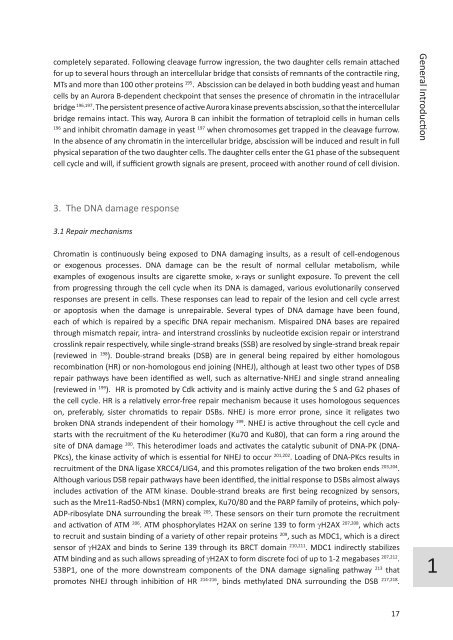Chromosome segregation errors: a double-edged sword - TI Pharma
Chromosome segregation errors: a double-edged sword - TI Pharma
Chromosome segregation errors: a double-edged sword - TI Pharma
Create successful ePaper yourself
Turn your PDF publications into a flip-book with our unique Google optimized e-Paper software.
completely separated. Following cleavage furrow ingression, the two daughter cells remain attached<br />
for up to several hours through an intercellular bridge that consists of remnants of the contractile ring,<br />
MTs and more than 100 other proteins 195 . Abscission can be delayed in both budding yeast and human<br />
cells by an Aurora B-dependent checkpoint that senses the presence of chromatin in the intracellular<br />
bridge 196,197 . The persistent presence of active Aurora kinase prevents abscission, so that the intercellular<br />
bridge remains intact. This way, Aurora B can inhibit the formation of tetraploid cells in human cells<br />
196 and inhibit chromatin damage in yeast 197 when chromosomes get trapped in the cleavage furrow.<br />
In the absence of any chromatin in the intercellular bridge, abscission will be induced and result in full<br />
physical separation of the two daughter cells. The daughter cells enter the G1 phase of the subsequent<br />
cell cycle and will, if sufficient growth signals are present, proceed with another round of cell division.<br />
3. The DNA damage response<br />
3.1 Repair mechanisms<br />
Chromatin is continuously being exposed to DNA damaging insults, as a result of cell-endogenous<br />
or exogenous processes. DNA damage can be the result of normal cellular metabolism, while<br />
examples of exogenous insults are cigarette smoke, x-rays or sunlight exposure. To prevent the cell<br />
from progressing through the cell cycle when its DNA is damaged, various evolutionarily conserved<br />
responses are present in cells. These responses can lead to repair of the lesion and cell cycle arrest<br />
or apoptosis when the damage is unrepairable. Several types of DNA damage have been found,<br />
each of which is repaired by a specific DNA repair mechanism. Mispaired DNA bases are repaired<br />
through mismatch repair, intra- and interstrand crosslinks by nucleotide excision repair or interstrand<br />
crosslink repair respectively, while single-strand breaks (SSB) are resolved by single-strand break repair<br />
(reviewed in 198 ). Double-strand breaks (DSB) are in general being repaired by either homologous<br />
recombination (HR) or non-homologous end joining (NHEJ), although at least two other types of DSB<br />
repair pathways have been identified as well, such as alternative-NHEJ and single strand annealing<br />
(reviewed in 199 ). HR is promoted by Cdk activity and is mainly active during the S and G2 phases of<br />
the cell cycle. HR is a relatively error-free repair mechanism because it uses homologous sequences<br />
on, preferably, sister chromatids to repair DSBs. NHEJ is more error prone, since it religates two<br />
broken DNA strands independent of their homology 199 . NHEJ is active throughout the cell cycle and<br />
starts with the recruitment of the Ku heterodimer (Ku70 and Ku80), that can form a ring around the<br />
site of DNA damage 200 . This heterodimer loads and activates the catalytic subunit of DNA-PK (DNA-<br />
PKcs), the kinase activity of which is essential for NHEJ to occur 201,202 . Loading of DNA-PKcs results in<br />
recruitment of the DNA ligase XRCC4/LIG4, and this promotes religation of the two broken ends 203,204 .<br />
Although various DSB repair pathways have been identified, the initial response to DSBs almost always<br />
includes activation of the ATM kinase. Double-strand breaks are first being recognized by sensors,<br />
such as the Mre11-Rad50-Nbs1 (MRN) complex, Ku70/80 and the PARP family of proteins, which poly-<br />
ADP-ribosylate DNA surrounding the break 205 . These sensors on their turn promote the recruitment<br />
and activation of ATM 206 . ATM phosphorylates H2AX on serine 139 to form gH2AX 207,208 , which acts<br />
to recruit and sustain binding of a variety of other repair proteins 209 , such as MDC1, which is a direct<br />
sensor of gH2AX and binds to Serine 139 through its BRCT domain 210,211 . MDC1 indirectly stabilizes<br />
ATM binding and as such allows spreading of gH2AX to form discrete foci of up to 1-2 megabases 207,212 .<br />
53BP1, one of the more downstream components of the DNA damage signaling pathway 213 that<br />
promotes NHEJ through inhibition of HR 214-216 , binds methylated DNA surrounding the DSB 217,218 .<br />
17<br />
General Introduction 1













